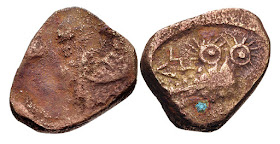The ancient coinage of Southern Arabia is one of the most obscure branches of numismatics. Its origin is Greek and its development is local.
Arabia, like Egypt, had no silver mines; therefore, silver was an exotic import. The earliest coins in the region were Athenian tetradrachms of the 5th century BCE. Produced in vast numbers, these “owls” became widely accepted in trade across much of the ancient world, because the silver they contained was relatively pure. Rulers of Saba in central Yemen, with its capital at Marib, soon realized that they could enhance their prestige and wealth by producing their own imitations of this coinage. The 17.2 gram tetradrachm was inconveniently large, so for centuries, South Arabian silver coins were based on a local unit of about 5.5 grams, with fractional denominations of a half, a quarter, an 8th and even a tiny 16th. As generations of die engravers made copies of copies, the designs deteriorated, so that the obverse head of Athena and the reverse owl become increasingly scraggly and schematic. A feature of this coinage is a prominent South Arabian letter on Athena’s cheek as a mark of denomination: “N” for the unit or drachm, “K” for rare double units (didrachm), “G” for the half (hemidrachm), “T” for the quarter, and “S” for the eighth.
Below there are samples of these coins which imitated the famous Athenian tetradrachm.
The kingdom of Qataban ~ Goddess Athena and owl
The kingdom of Himyar emerged in the southwestern corner of Yemen in the 2nd century BCE and eventually absorbed the other states of the region, extending its power over much of Arabia.
Hadhramawt
The remote kingdom of Hadhramawt (or Hadramaut) in Yemen’s Eastern desert had rich deposits of copper and issued crude bronze “owls” as early as the third century BCE. From the 1st century BCE until it was eventually absorbed by Himyar.SOURCE : Coinweek















No comments:
Post a Comment